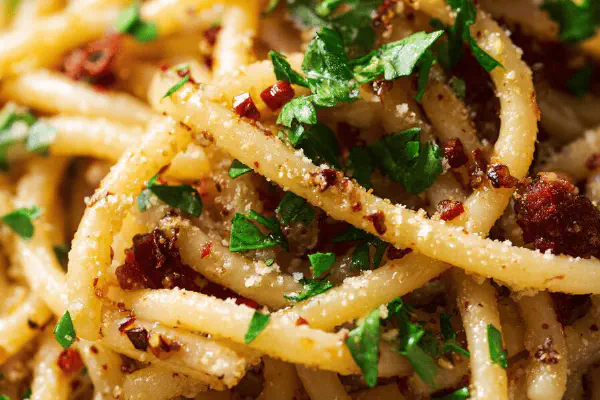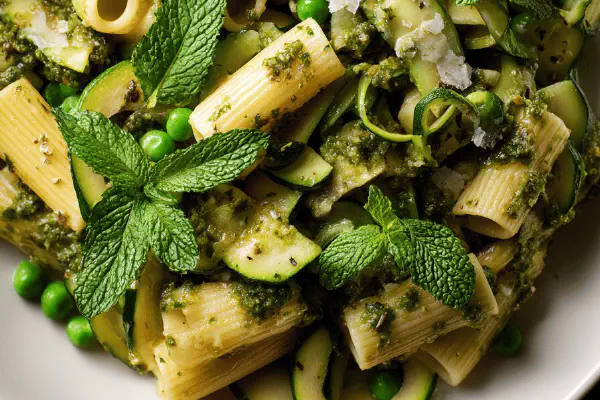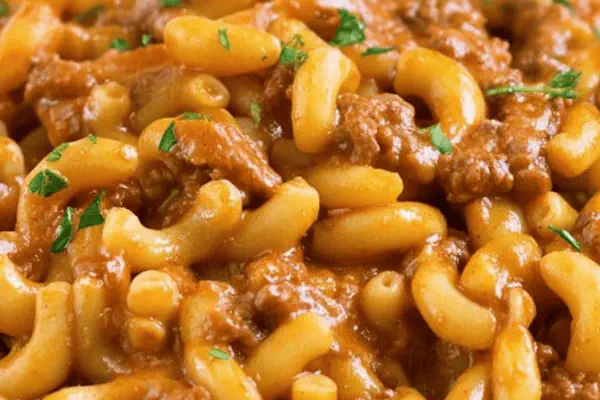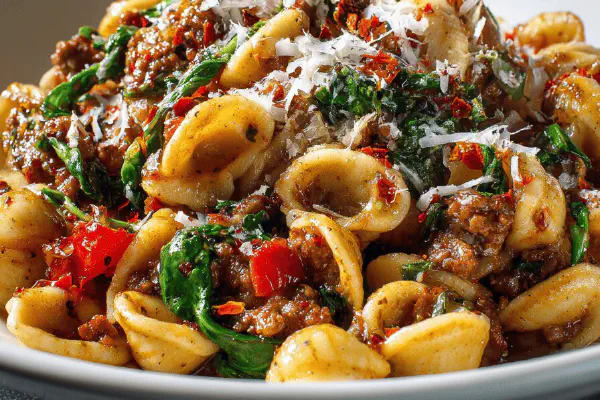Amatriciana Twist Pasta

By Emma
Certified Culinary Professional
Ingredients
- 3 gousses d’ail, hachées
- 25 ml (1 ½ c. à soupe) d’huile d’olive
- 1 boîte de 550 ml (19 oz) tomates italiennes entières
- 170 g (3/8 lb) guanciale, coupée en dés de 1 cm
- 340 g (3/4 lb) bucatinis
- 60 g (2/3 tasse) de pecorino romano frais râpé
- 15 ml (1 c. à soupe) vin blanc sec
- 10 g (1 c. à soupe) tomates séchées, hachées
- persil frais haché, pour garnir
- poivre fraîchement moulu
- pincée de piment rouge broyé
About the ingredients
Method
- Écraser l’ail finement. Chauffer l’huile dans une casserole à feu moyen. Ajouter l’ail, cuire 2 minutes sans dorer.
- Incorporer tomates entières, vin blanc, tomates séchées, piment rouge. Laisser mijoter 15 minutes. Écraser doucement les tomates à la fourchette pour avoir une sauce grumeleuse, pas complètement lisse. Cuire encore 4 minutes.
- Dans une grande poêle, cuire le guanciale à feu moyen-doux 7 minutes. Retirer quand gras rendu et morceaux bien croquants. Égoutter sur papier absorbant. Poivrer légèrement.
- Chauffer grande casserole d’eau salée. Cuire bucatinis 8 minutes, très al dente. Réserver 200 ml d’eau de cuisson, égoutter.
- Verser pâtes dans la sauce tomate. Ajouter eau de cuisson petit à petit. Cuire 6 minutes, mélanger souvent. Épaissir sauce, pâtes s’imprègnent.
- Retirer du feu. Ajouter pecorino, remuer vigoureusement. Incorporer guanciale.
- Garnir de persil frais. Servir immédiatement avec un moulin de poivre.
Cooking tips
Chef's notes
- 💡 Garlic crushed fine not chopped rough. Sweat gently in olive oil low heat. Avoid browning burnt bitter notes. You want aroma not color. Add after olive oil warm, stir constantly for 2 mins max. Timing critical. Don’t rush or scorch it.
- 💡 Cook guanciale slow medium-low heat 7 minutes. Render fat gradually keep pieces crisp. Paper towel drain excess fat after. Saving fat adds flavor but overdo makes greasy. Poivre sprinkled early to begin seasoning pork as fat renders.
- 💡 Pasta boiled very al dente exactly 8 mins. Reserve 200 ml pasta water before draining. Water starch binds sauce avoids extra oil. Mix pasta off heat in sauce first then simmer 6 mins low stir often. Thickens sauce, lets noodles soak flavor, texture contrast matter here.
- 💡 Tomatoes simmer 15 mins crushed with fork mid-way for rustic chunks. Not smooth puree. Adding sun-dried tomatoes chopped adds umami and depth. White wine early in sauce lifts acidity, balances pork fat. Shorter simmer keeps brightness intact, avoids heavy sauce.
- 💡 Add pecorino off heat only. Stir vigorously so cheese melts evenly coats pasta. Prevents clumping. Final toss with crispy guanciale last step keeps textures distinct. Garnish fresh parsley chopped raw for fresh contrast on rich, smoky background.
Common questions
Can I substitute pancetta for guanciale?
Yeah but flavor changes — guanciale fattier less salty. Pancetta quicker to crisp less depth. Cook time slight tweak needed. Garlicky, smoky punch less intense. Use pancetta same cook method just watch fat render.
Can dry rigatoni replace bucatini?
Usually yes. Bucatini hollow helps sauce cling inside pasta tube. Rigatoni thick outside holds sauce differently. Cook rigatoni al dente but test bite earlier. Sauce absorption trick less pronounced but still tasty. Adjust simmer to avoid mush.
What if sauce turns too thin?
Add reserved pasta water gradually not all at once. Simmer with pasta longer to thicken clever. If loose after, take off heat add more pecorino stirs in thick coat. Or simmer uncovered briefly to reduce moisture. Avoid extra oil to keep balance.
How to store leftovers?
Cool quickly, fridge 2-3 days max. Reheat low heat with splash pasta water for moisture. Not microwave high power — dries out cheese sauce. Freeze possible but texture changes, omit parsley garnish until fresh serving. Warm gently for best texture.



